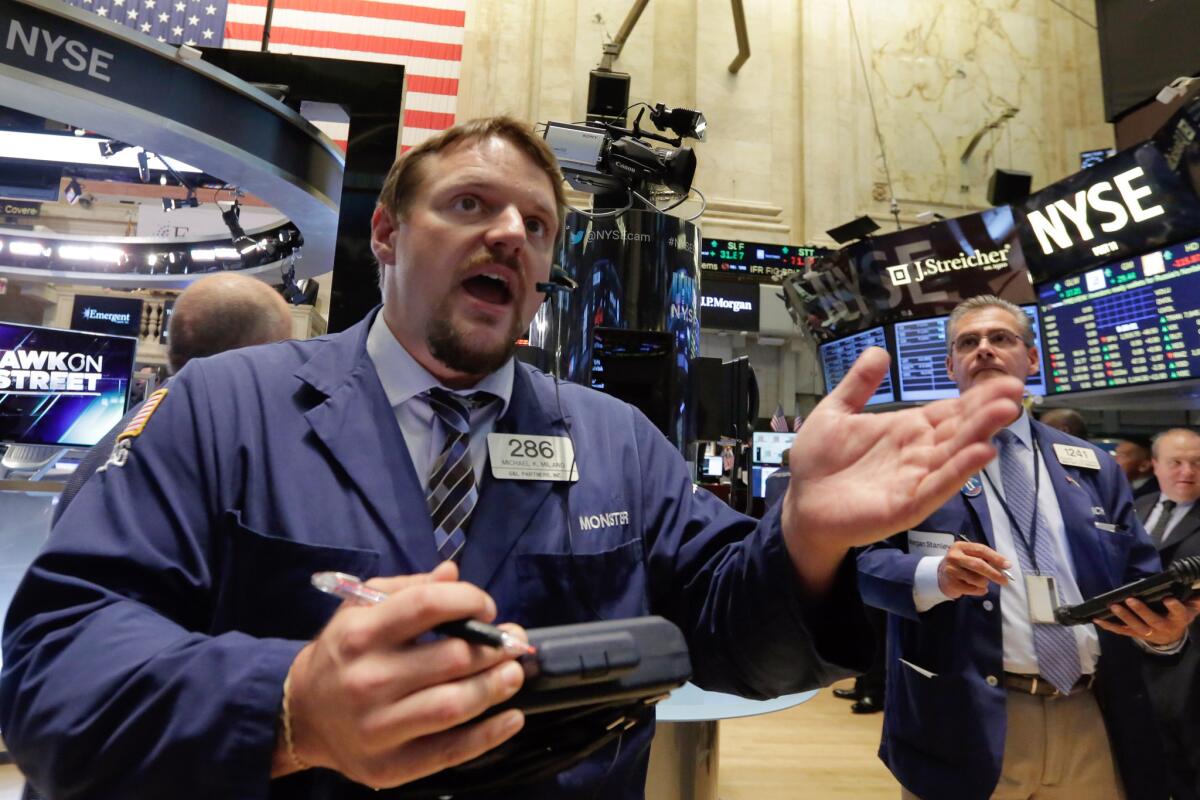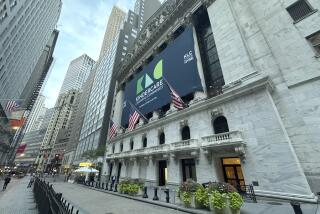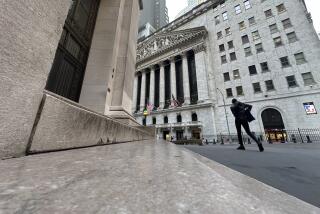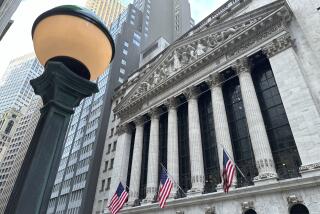U.S. stocks plummet on China fears; Dow down 12.5% from peak

Trader Michael Milano works on the floor of the New York Stock Exchange on Sept. 1.
A small bit of bad economic news from China sparked a big global reaction as U.S. stocks followed the rest of the world’s markets down sharply Tuesday, a sign of investors’ deepening concerns about the strength of the Chinese economy.
The blue-chip Dow Jones industrial average dropped nearly 3%, falling 469.68 points, to 16,058.35, while the broad-based Standard & Poor’s 500 index fell 58.33, also about 3%, to 1,913.85.
The latest sell-off comes after stocks rebounded last week with the biggest two-day rally in seven years and continues the wild volatility that has marked trading sessions for more than two weeks. Despite the two-day gain, Dow has lost nearly 2,500 points over nine other days.
The trading also opens a month that is historically a bad one for stocks. September is the only month of the year in which the Standard & Poor’s 500 index has fallen more often than it has risen in the post-World War II era, according to Sam Stovall, U.S. equity strategist for S&P Capital IQ.
It’s also the month that has produced the worst average return, a negative 0.63%, compared with a positive 0.66% for the average month from the end of 1945 through Friday.
The immediate cause of Tuesday’s sell-off was likely the release of new data showing weaker-than-expected manufacturing in China, prompting fears of a so-called hard landing as the country’s economy decelerates, said David Schegoleit, managing director of investments for U.S. Bank’s wealth management unit.
Investors also have watched with concern the Chinese government’s fitful attempts to control both its markets and its broader economy.
“The Chinese government has been trying to walk a tightrope,” Schegoleit said. “It’s wanted to be respected as a world player and economic power, while not wanting to accept the downsides that come with it.”
He noted that major factors fueling investor fears are a lack of confidence in China’s official economic figures and a lack of transparency in its economy and markets generally.
“This is what happens when lack of visibility runs up against fear and stress in the markets,” Schegoleit said.
But analysts said that, at this point, the sell-off may be an overreaction, particularly given the relative strength of the U.S. recovery.
China has both the will and the ability to keep its economy from slowing too quickly and will do so, even it means creating other problems in the future, said Marc Pado, president of DowBull Consulting in Lake Tahoe, Nev.
“They’re trying to figure it out,” he said of Chinese leaders. “The key here is, they will figure something out, and we’re overreacting in the meantime.”
China’s official manufacturing purchasing-managers index fell to 49.7 in August from 50 a month ago, falling short of market forecasts of 49.8. Investors interpreted the figures as showing signs of contraction.
That world markets reacted with such force to relatively small moves in a formerly obscure Chinese economic metric showed the degree of anxiety that has gripped investors.
China has taken a range of extraordinary fiscal, economic and financial measures in somewhat clumsy fashion to reassure investors, with little success so far.
Earlier in the summer, Chinese regulators relaxed rules on margin borrowing and banned company shareholders with stakes of more than 5% from selling for six months.
China’s central bank extended billions in loans to state-owned banks to “encourage banks to increase support” for struggling sectors of the economy, according to the state-run Xinhua News Agency.
Then, in August, China devalued its currency, sending new shudders through markets.
The sell-off of U.S. shares, which appeared to be finding at least a temporary bottom in the morning before slipping further, followed similarly deep slides in European markets.
Germany’s DAX and France’s CAC 40 both dropped 2.4%, and Britain’s FTSE fell 3%. In Asia, China’s Shenzhen market was off 4.6% and the Shanghai composite 1.2%. Japan’s Nikkei index lost 3.8%.
In the United States, the Dow’s fall amounted to a 12.5% drop from its May 19 high for the year. That put it once again into a so-called correction, which is a drop of 10% or more from a recent high. The Dow was off 9.9% for the year.
The S&P and the tech-oriented Nasdaq composite index also hit correction territory.
The S&P fell 10.3% from its May 20 high and is down 7.1% for the year. The Nasdaq lost 140.40 points Tuesday, also nearly 3%, to 4,636.10. It has dropped 11.4% from its July 20 high but is down only 2.1% for the year.
A key concern beyond the depth of China’s economic troubles is the degree to which the U.S. economy can continue to expand in the midst of sluggish growth around the world.
The U.S. economy “is now holding up relatively well despite the challenges in China and some other emerging markets,” noted Russ Koesterich, global chief investment strategist for New York’s BlackRock Inc.
Amid the international market turmoil, investors will be paying particular attention to the monthly U.S. employment report for August. The report, scheduled to released by the Commerce Department on Friday, will include nonfarm payrolls, the unemployment rate, average hourly earnings and other data documenting the health of the recovery.
It’s the “biggest group of reports this month,” said Randy Frederick, Schwab’s managing director of trading and derivatives.
More to Read
Inside the business of entertainment
The Wide Shot brings you news, analysis and insights on everything from streaming wars to production — and what it all means for the future.
You may occasionally receive promotional content from the Los Angeles Times.











